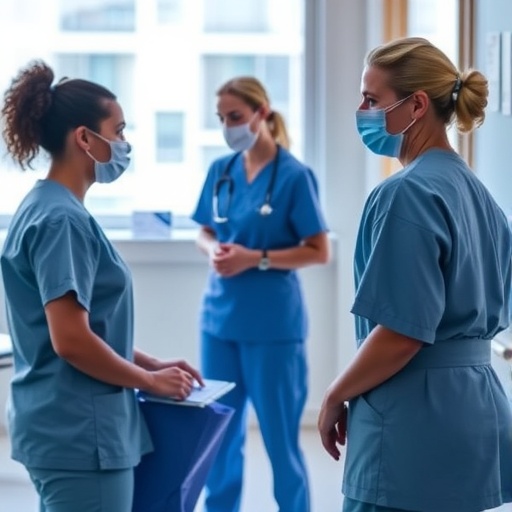BIRMINGHAM, Ala. – How do a wide variety of bacteria — both pathogenic and commensal — survive antimicrobials released by the mammalian innate immune system?

Credit: UAB
BIRMINGHAM, Ala. – How do a wide variety of bacteria — both pathogenic and commensal — survive antimicrobials released by the mammalian innate immune system?
The answer for one of the antimicrobials — hypothiocyanite/hypothiocyanous acid, or OSCN– and HOSCN — has been reported by Michael Gray, Ph.D., and colleagues through discovery of a novel role for an enzyme in E. coli. This previously unknown activity is also exhibited by homologous enzymes found in pathogenic Streptococcus and Staphylococcus bacteria and several commensal gut microbes.
“During inflammation, the human immune system releases a variety of reactive and damaging antimicrobials meant to fight off invading pathogens,” said Gray, an assistant professor in the University of Alabama at Birmingham Department of Microbiology. “Understanding how bacteria can evade these powerful oxidants, including the hypohalous acids like HOSCN, is crucial to human health.
“By identifying the function of the enzyme RclA in the model organism E. coli — which notably is able to compete with commensal organisms and thrive in an inflamed gut — we have laid the foundation for understanding bacterial survival and the relationship to the human immune system in ways that were previously not understood,” Gray said.
“E. coli especially thrives in the chronically inflamed environment found in patients with inflammatory bowel disease, and it is able to compete with and outgrow other important commensal organisms, suggesting that HOSCN may be a relevant antimicrobial in the gut, which has not previously been explored,” he said.
HOSCN is known to be abundant in saliva and airway secretions as a highly specific antimicrobial that is nearly harmless to mammalian cells. However, some microbes, including pathogens, can escape HOSCN damage during inflammation, permitting continued growth and even severe disease.
Reporting in the journal Proceedings of the National Academy of Sciences, researchers led by Gray and Frederick Stull, assistant professor of chemistry at Western Michigan University, Kalamazoo, explain that the E. coli flavoprotein RclA reduces HOSCN to harmless thiocyanate with near-perfect catalytic efficiency, and this extremely fast activity strongly protects E. coli against HOSCN toxicity. HOSCN thus appears to be the physiologically relevant substrate for RclA, Gray says, rather than its previously described ability to modestly resist reactive chlorine.
The researchers also tested the homologous flavin-dependent oxidoreductases found in Streptococcus pneumonia, Staphylococcus aureus and in Bacteroides thetaiotaomicron. S. pneumonia and S. aureus are pathogens known to colonize tissues during chronic inflammation, especially in the lungs, where they should come into contact with high concentrations of HOSCN. B. thetaiotaomicron is an important human gut commensal.
Their three flavin-dependent oxidoreductases — which show 47 percent to 49 percent amino acid sequence identity with E. coli RclA — were cloned into E. coli, where they all displayed potent activity against HOSCN. The active sites of RclA and the three homologs show close amino acid sequence identity.
HOSCN acts by quickly oxidizing sulfur-containing amino acids in bacterial proteins, especially cysteine. Oxidoreductases like RclA contain two cysteine residues at their active site. These two cysteines presumably are important for the enzyme’s function, yet they are a most likely target for HOSCN. The researchers showed that each active-site cysteine in RclA was necessary for RclA function, and that they act together to rapidly reduce HOSCN, using NAD(P)H.
“Perhaps our most exciting finding is that homologs of RclA, including from the gut commensal species B. thetaiotaomicron and Limosilactobacillus reuteri and from species implicated in serious lung disease protect against HOSCN damage to the same degree as E. coli RclA,” Gray said. “This indicates that a wide range of bacteria, both commensal and pathogenic, may possess specific defenses against HOSCN stress. Learning more about the scope of protection provided by this enzyme to pathogenic species will gain us better knowledge on potentially a wide range of diseases, including cystic fibrosis, inflammatory bowel disease and oral diseases.
“While we have not yet directly addressed the effect of this enzyme on host colonization in vivo, we have laid an important foundation for future studies with the data we have gathered here,” Gray said.
Co-first authors in the PNAS study, “Escherichia coli RclA is a highly active hypothiocyanite reductase,” are Julia D. Meredith, UAB Department of Microbiology, and Irina Chapman, Western Michigan University. Co-authors besides Gray, Stull, Meredith and Chapman are Kathrin Ulrich, University of Michigan, Ann Arbor, and Caitlyn Sebastian, UAB Department of Microbiology.
Support came from National Institute of Health grants GM124590 and GM122506, and from Western Michigan University.
At UAB, Microbiology is a department in the Marnix E. Heersink School of Medicine.
Journal
Proceedings of the National Academy of Sciences
DOI
10.1073/pnas.2119368119
Method of Research
Experimental study
Subject of Research
Cells
Article Title
Escherichia coli RclA is a highly active hypothiocyanite reductase
Article Publication Date
22-Jul-2022
COI Statement
None




